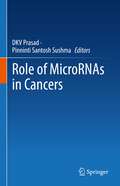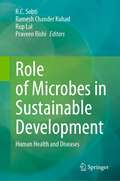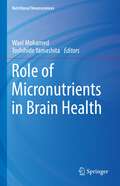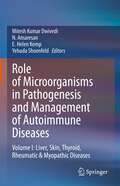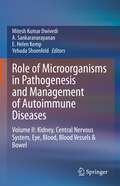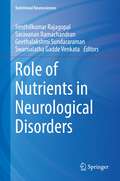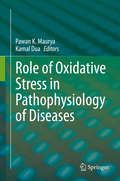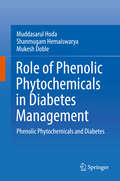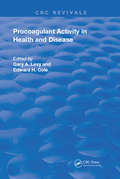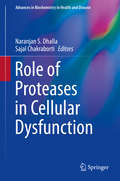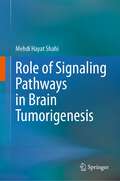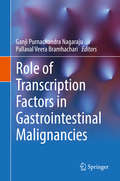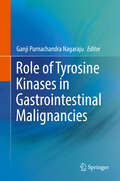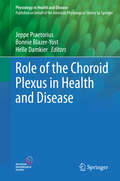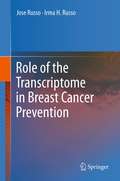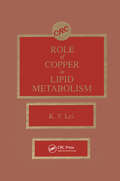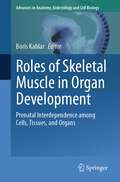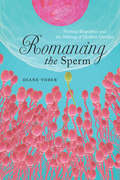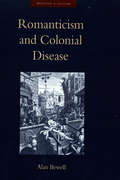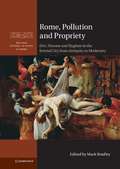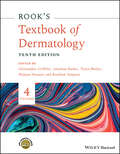- Table View
- List View
Role of MicroRNAs in Cancers
by Dkv Prasad Pinninti Santosh SushmaThis book discusses the potential roles of miRNA as a crucial regulator in cancer biology. It examines the regulation of drug resistance by miRNAs in cancers and the mechanism of their deregulated expression. The book discusses the role and molecular mechanism of miRNA in regulating cellular proliferation and cell cycle. It analyses circulating miRNAs as biomarkers for cancer diagnosis and prognosis. It also analyzes the role of miRNA as a modulator of the development and function of tumor-associated immune cells. It explores the cross-talk between miRNA and reactive oxygen species (ROS) in pathogenesis, cancer therapeutic tolerance, and resistance. It provides insights into the role of miRNA in cancer angiogenesis, metastasis and describes strategies and associated challenges of miRNA-based therapies.
Role of Microbes in Sustainable Development: Human Health and Diseases
by Ramesh Chander Kuhad R. C. Sobti Rup Lal Praveen RishiThis book examines the role of human microbiome in human health and diseases. The initial chapters present tools for genetic manipulation of gut microbiota and the therapeutic applications of engineered microbiota. They discuss the interaction between human microbiota and host in defining the prominent role of microbes in the development and progression of major human diseases. The book also summarizes the current applications and trends for the development, production and analytical characterization of recombinant therapeutic proteins in microbial systems. It also reviews the role of microbes in the production of vaccines and antibiotics. Further, the book presents bacterial products, including proteins, enzymes, immunotoxins and secondary metabolites, that target cancer cells and cause tumour regression. The chapters also discuss the critical role of gut microbiota dysbiosis in the pathogenesis of autoimmune disease and in bowel-related diseases. Towards the end, the book explores the role of intestinal microbiota in metabolic health and the pathogenesis of common metabolic disorders. It presents state-of-the-art insights into important aspects of United Nations—Sustainable Developmental Goal 3.
Role of Micronutrients in Brain Health (Nutritional Neurosciences)
by Wael Mohamed Toshihide YamashitaThis book comprehensively reviews the relationship between micronutrients and brain in health and diseases. It explains the relationship between micronutrients and brain functions, neurogenesis, and cognitive functions. The book also explores the relationship between micronutrients and brain disorders including depression, epilepsy, PD, and Autism. It further explores the recent advancements in understanding the important role of micronutrients as therapeutics in various brain disorders like TBI and AD. Lastly, it presents an overview of micronutrients as neuroprotective agents along with the main principles of nutrigenomics.
Role of Microorganisms in Pathogenesis and Management of Autoimmune Diseases: Volume I: Liver, Skin, Thyroid, Rheumatic & Myopathic Diseases
by Yehuda Shoenfeld N. Amaresan Mitesh Kumar Dwivedi E. Helen KempThis book in the two volume set provides comprehensive coverage on how microbial pathogens can subvert our immune system into responding against self and resulting into autoimmune diseases. In particular, the book covers the different aspects of linking gut microbiota dysbiosis with autoimmune mechanisms involved in disease development to identify future effective approaches based on the gut microbiota for preventing these autoimmune diseases.Contributions in the book focuses on the role of microbiota/probiotics and their distinct mechanisms exerted in management of autoimmune liver, skin, thyroid, rheumatic and myopathic diseases. This could help in better understanding to design therapeutic strategies that can be deployed to prevent these autoimmune diseases.The book has an interdisciplinary appeal and scholars with an interest immunology, medical microbiology and nutritional sciences will value its contribution. Overall, the book gives a new dimensions and insight in the aspects of microbial role in autoimmune disease pathogenesis and therapeutic aspects.
Role of Microorganisms in Pathogenesis and Management of Autoimmune Diseases: Volume II: Kidney, Central Nervous System, Eye, Blood, Blood Vessels & Bowel
by Yehuda Shoenfeld A. Sankaranarayanan Mitesh Kumar Dwivedi E. Helen KempThis book, which is the second volume of Role of Microorganisms in Pathogenesis and Management of Autoimmune Diseases, provides comprehensive coverage on how microbial pathogens can subvert our immune system into responding against self and resulting in autoimmune diseases. In particular, the book covers the different aspects of linking gut microbiota dysbiosis with autoimmune mechanisms involved in disease development to identify future effective approaches based on the gut microbiota for preventing these autoimmune diseases.Contributions in the book focus on the role of microbiota/probiotics and their distinct mechanisms exerted in the management of autoimmune diseases of the kidney, central nervous system, eye, blood vessel, and bowel. This could help in better understanding to design of therapeutic strategies that can be deployed to prevent these autoimmune diseases.The book has an interdisciplinary appeal and scholars with an interest in immunology, medical microbiology, and nutritional sciences will value its contribution. Overall, the book gives new dimension and insight into the aspects of microbial role in autoimmune disease pathogenesis.
Role of Nutrients in Neurological Disorders (Nutritional Neurosciences)
by Senthilkumar Rajagopal Saravanan Ramachandran Geethalakshmi Sundararaman Swarnalatha Gadde VenkataThis book provides the latest research on the role of nutrients in the prevention and treatment of neurological disorders. It discusses dietary supplements and dietary restrictions for combating neurological disorders, including Alzheimer’s disease, Parkinson’s disease, stroke, and epilepsy. The book also explains the impact of different nutrients such as herbal products, algae, micronutrients in stimulating the brain and central nervous system during abnormal functions. It covers the effect of the nutrients on the function of neurotransmitters, their stimulatory effect in autism, dementia, Alzheimer’s, and other neuropathological states. The book also defines the mechanistic effects of neuroprotective and psycho protective effects of natural food in repairing brain damage. This book is essential reading for neuroscientists and neurologists, and healthcare professionals.
Role of Oxidative Stress in Pathophysiology of Diseases
by Pawan K. Maurya Kamal DuaThis book illustrates the importance and significance of oxidative stress in the pathophysiology of various human diseases. The book initially introduces the phenomenon of oxidative stress, basic chemical characteristics of the species involved and summarizes the cellular oxidant and anti-oxidant system and the cellular effects and metabolism of the oxidative stress. In addition, it reviews the current understanding of the potential impact of oxidative stress on telomere shortening, aging, and age-related diseases. It also examines the role of oxidative stress in chronic diseases, including cancer, diabetes, cardiovascular diseases, and neurodegenerative disorders. Further, the book presents novel technologies for the detection of oxidative stress biomarkers using nanostructure biosensors, as well as in vitro and in vivo models to monitor oxidative stress. Lastly, the book addresses the drug delivery carriers that can help in combating oxidative stress.
Role of Phenolic Phytochemicals in Diabetes Management: Phenolic Phytochemicals and Diabetes
by Mukesh Doble Muddasarul Hoda Shanmugam HemaiswaryaThis book summarizes the latest research trends in phytophenolic therapy for the management of diabetes. It discusses the various mechanisms of action of phytophenolics present in food, fruits and plants that can be used to control/reverse diabetic conditions. Further, it addresses the synergistic interactions of phytophenolics with anti-diabetic drugs, as understanding them can yield valuable insights for complementary and alternative medicine. In closing, it discusses the important aspects of nanotechnology-based targeted delivery and improving the bioavailability of phenolic phytochemicals, two major areas of research in phytotherapy of diabetes.
Role of Procoagulant Activity in Health and Disease (Routledge Revivals)
by Gary A. LevyFirst published in 1994, Role of Procoagulant Activity in Health and Disease discusses different aspects of the pathobiology and consequences of the induction of cellular procoagulants. The first part of the book addresses the molecular and cellular biology of procoagulant activity induction (PCA). This includes the recent data on cellular pathways of induction of PCA and the molecular nature of the different procoagulants identified to date. The book addresses interactions between macrophages and endothelial cells, focusing on those aspects most relevant to induction of procoagulant activities, including the role of adhesion molecules. The second portion of the book describes the relevance of PCA to a number of human and experimental diseases, including infectious diseases, gastrointestinal diseases, liver disease, renal disease, neoplastic diseases, allograft rejection, and pulmonary disease. This book will not only be of value to the basic scientist, but also to pathologists and clinicians, and to others wishing to understand the role of immunologically mediated induction of cellular coagulants and their relevance to disease.
Role of Proteases in Cellular Dysfunction
by Naranjan S. Dhalla Sajal ChakrabortiIt is now well known that proteases are found everywhere, in viruses and bacteria as well as in all human, animal and plant cells, and play a role in a variety of biological functions ranging from digestion, fertilization, development to senescence and death. Under physiological conditions the ability of proteases is regulated by endogenous inhibitors. However, when the activity of proteases is not regulated appropriately, disease processes can result, as seen in Alzheimer's disease, cancer metastasis and tumor progression, inflammation and atherosclerosis. Thus it is evident that there is an absolute need for a tighter control of proteolytic activities in different cells and tissues. Aimed at graduate students and researchers with an interest in cellular proteolytic events, Role of Proteases in Cellular Dysfunctions is the second book on Proteases in this series. The book consists of three parts in specified topics based on current literatures for a better understanding for the readers with respect to their subject-wise interests. The first section of this book covers a brief idea about the neuronal disorders and the involvement of proteases such as calpains, caspases and matrix metalloproteases (MMPs). The second section covers the deadly disease cancer and its relation to ubiquitin-proteasome system, MMPs and serine proteases. The last section is about the role of proteases such as calpains, MMPs and serine protease as well as urokinase type plasminogen activator receptor (uPAR) in causing cardiovascular defects.
Role of Signaling Pathways in Brain Tumorigenesis
by Mehdi Hayat ShahiThis book provides acomprehensive overview of cell signalling pathways and morphogens in the genesis of brain tumours. It also explains the role of brain tumour stem cells in the brain tumour progression. It also elucidates the novel early biomarkers that can be utilized to diagnose brain tumours. It presents the basic developmental pathways and morphogens, including retinoic acid and TGF-b that promote brain tumorigenesis. The chapters illustrate the role of stem cells and stem cells mediated cell signalling pathways including, Sonic hedgehog, Notch, Wnt in the brain tumour growth. The chapters also emphasize the role of transcription factors, mainlyNanog, Sox, BMI1, HIF1 and Pax6 in the brain tumouriogensis. It highlights the role of NF-kb, Myc and neurotrophins in the brain tumour development. Finally, the book summarizes the potential early therapeutic targets and targeted drug discovery for brain tumours.
Role of Transcription Factors in Gastrointestinal Malignancies
by Ganji Purnachandra Nagaraju Pallaval Veera BramhachariThis book illustrates the importance of transcription factors in gastrointestinal cancer progression and metastasis with regard to understanding the mechanism and target definition in drug discovery. Further, it describes the complex issues associated with cancer cell growth and metastasis. The respective chapters provide detailed information on the various types of transcription factors (NF-kB, HIF-1, STAT-3, E2F1, and Sp1) and gastric-associated cancers (esophagus, stomach, colorectal, liver and pancreatic cancers) in connection with specific functional studies like cell cycle, angiogenesis, migration, invasion and apoptosis. These transcription factors control the expression of several signaling pathways involved in tumor growth, making them ideal targets for gastrointestinal cancer therapy. In closing, the book provides comprehensive descriptions of the major challenges associated with gastrointestinal cancer therapy.
Role of Tyrosine Kinases in Gastrointestinal Malignancies
by Ganji Purnachandra NagarajuThe aim of this book is to provide comprehensive overview of the role of different tyrosine kinases in the progression and metastasis of various cancers of the gastrointestinal tract such as esophagus, liver, pancreas, stomach, and colorectal. Activation of various signaling pathways and tyrosine kinases are responsible for resistance to chemo and radiotherapy in these gastrointestinal malignancies. Targeting these tyrosine kinases, which regulate the activities of survival pathways in growth, and metastasis is a rational strategy in gastrointestinal cancer therapy. Each chapter embedded in this book covers information pertaining to a specific tyrosine kinase and its impact on various malignancies, which is not only significant for basic and clinical research investigations but will also be valued by students at advanced undergraduate to postgraduate levels.
Role of the Choroid Plexus in Health and Disease (Physiology in Health and Disease)
by Jeppe Praetorius Bonnie Blazer-Yost Helle DamkierThis book highlights the importance of the choroid plexus, which forms the blood-cerebrospinal fluid barrier and is the site of the major production of the cerebrospinal fluid (CSF). The authors show that this barrier is crucial for maintaining important compositional differences between the blood plasma and the CSF. The choroid plexus epithelial cells also prevent the spread of infectious agents and other blood-borne entities to the brain tissue. Chapter topics range from the production of CSF by electrolyte regulation in the choroid plexus, to details on the selectively transporting nature of this barrier. Further, the authors elaborate on the important roles of CSF in sustaining brain health by providing hydration, solutes, and nutrients to the brain tissue. Readers will also learn how CSF circulates signaling molecules within the compartments of the brain and removes waste products from the brain tissue. Elucidating the regulation of these processes in the choroid plexus is not only important for the readers’ understanding of normal brain development and function, but is also crucial for resolving a variety of cerebral challenges that lead to brain edema, as well as developing treatments for diseases. The book discusses disease models like hydrocephalus, sleep disorders, and age-related dementia. Its comprehensive coverage makes this volume a valuable resource for researchers in cell and neurophysiology, as well as graduate students of the neurosciences.
Role of the Transcriptome in Breast Cancer Prevention
by Jose Russo Irma H. RussoThis book will provide the latest advances in molecular and cellular biology for establishing the foundation of a complete understanding of the mechanisms of breast differentiation leading to cancer prevention. The authors are based on the epidemiological evidence indicating that early first full term pregnancy is a protective factor in human against breast cancer and they have used this paradigm and developed experimental systems in both in vivo and in vitro that have demonstrated mechanistically how the differentiation at the organ and cellular level takes place. This knowledge has provided the blueprint for developing better understanding of the basis of cancer prevention. The transcriptoma analysis of the breast of pre and post-menopausal women has established a genomic signature imprinted in the breast that differs according to the reproductive history of the woman showing that early first full term pregnancy reprogram the organ. This reprogramming takes place at the chromatin level by changing the transcriptional process. The modification of the transcriptional control is due to the expression of non coding RNA sequences and posttranscriptional control driven by the splicesome. The plasticity of the genome of the human breast make possible this reprogramming that is not only induced by the physiological process of pregnancy but by the use of hormones that mimic pregnancy without pregnancy. The author have established the basis of clinical trials for prevention and the discovery that short 15aa peptides of the chorionic gonadotropin hormone can be used in human breast cancer prevention based on preclinical and clinical data.
Roles of Copper in Lipid Metabolism
by Kai Y. LeiThe aim of this book is to provide a reference for researchers in the field of trace mineral and lipid metabolism. It addresses the influence of dietary copper status on cholesterol, lipoprotein and apolipoprotein metabolism as well as lipoprotein receptor characteristics. This fascinating volume critically reviews alterations in long chain fatty acid, prostaglandin and cardiac lipid metabolism, as well as arterial morphology induced by copper deficiency. Furthermore, it presents the theoretical relationship plus the anatomical, chemical and physiological similarities between copper deficiency and ischemic heart disease. This reading is indispensable for investigators interested in the role of copper in lipid metabolism.
Roles of Host Gene and Non-coding RNA Expression in Virus Infection (Current Topics in Microbiology and Immunology #419)
by Ralph A. Tripp S. Mark TompkinsRoles of Host Gene and Non-coding RNA Expression in Virus Infection
Roles of Skeletal Muscle in Organ Development: Prenatal Interdependence among Cells, Tissues, and Organs (Advances in Anatomy, Embryology and Cell Biology #236)
by Boris KablarMuscle is the only tissue of the four basic types that make the body that can be completely ablated while allowing fetal survival. This book is a result of 25 years of research employing engineered mouse fetuses with no skeletal muscle, a model system that provides a unique opportunity to study body development holistically. A systematic anatomical analysis of such fetuses have shown that several anatomical locations are affected by the absence of the skeletal muscle. This book contains a summarized description of affected anatomical locations such as the alveolar lung epithelium, motor neurons and giant pyramidal cells in the CNS, cholinergic amacrine cells of the retina, and type I hair cells of the crista ampullaris. Several specific bioinformatics and systems biology interventions are also described. The book provides an update on skeletal muscle development, musculoskeletal developmental interactions, trophic relationships between the skeletal muscle and the motor neurons, mechanics of lung development, functional development of two special senses, eye and ear, and finally, skeletal muscle-related reasons for human fetal akinesia and its consequences. This volume in the Advances in Anatomy, Embryology and Cell Biology series stresses the need to think about the developing body and its organs in terms of their mutual interdependence, and to think about diseases, such as pulmonary hypoplasia, amyotrophic lateral sclerosis, or cleft palate, in terms of that interdependence. Directed to developmental biologists, neuroscientists, tissue engineers and health professionals, this book exposes the ideas of interorgan communication and interdependence in homeostasis and disease.
Romancing the Sperm: Shifting Biopolitics and the Making of Modern Families
by Diane ToberThe 1990s marked a new era in family formation. Increased access to donor sperm enabled single women and lesbian couples to create their families on their own terms, outside the bounds of heterosexual married relationships. However, emerging “alternative” families were not without social and political controversy. Women who chose to have children without male partners faced many challenges in their quest to have children. Despite current wider social acceptance of single people and same sex couples becoming parents, many of these challenges continue. In Romancing the Sperm, Diane Tober explores the intersections between sperm donation and the broader social and political environment in which “modern families” are created and regulated. Through tangible and intimate stories, this book provides a captivating read for anyone interested in family and kinship, genetics and eugenics, and how ever-expanding assisted reproductive technologies continue to redefine what it means to be human.
Romani Chronicles of COVID-19: Testimonies of Harm and Resilience (New Directions in Romani Studies #6)
by Paloma Gay y Blasco Martin FottaA ground-breaking volume that gathers the testimonies of NGO workers, street vendors, activists, scholars, health professionals, and creative writers to chronicle the devastating impact of COVID-19 on Romani communities globally. The contributors reveal how the pandemic has exacerbated Romani disenfranchisement and document the resilience and creativity with which Romanies have responded to the crisis. Deploying innovative textual formats, and including poignant personal reflections, memoirs, scholarly analyses, and diary excerpts, the volume provides a roadmap for collaboration and dialogue at a time of global emergency. This is the most significant chronicle of Romani stories about the COVID crisis ever assembled. From the Introduction: The contributions include memoirs, opinion essays, transcriptions of conversations or interviews, ethnographic analyses, and a compelling short story by Romani writer Iveta Kokyová, as well as pieces that stride the boundaries between one or more of these genres, or that fit into none.
Romanticism and Colonial Disease (Medicine and Culture)
by Alan BewellColonial experience was profoundly structured by disease, as expansion brought people into contact with new and deadly maladies. Pathogens were exchanged on a scale far greater than ever before. Native populations were decimated by wave after wave of Old World diseases. In turn, colonists suffered disease and mortality rates much higher than in their home countries. Not only disease, but the idea of disease, and the response to it, deeply affected both colonizers and those colonized.In Romanticism and Colonial Disease, Alan Bewell focuses on the British response to colonial disease as medical and literary writers, in a period roughly from the end of the eighteenth century to the middle of the nineteenth century, grappled to understand this new world of disease. Bewell finds this literature characterized by increasing anxiety about the global dimensions of disease and the epidemiological cost of empire. Colonialism infiltrated the heart of Romantic literature, affecting not only the Romantics' framing of disease but also their understanding of England's position in the colonial world.The first major study of the massive impact of colonial disease on British culture during the Romantic period, Romanticism and Colonial Disease charts the emergence of the idea of the colonial world as a pathogenic space in need of a cure, and examines the role of disease in the making and unmaking of national identities.
Rome, Pollution and Propriety
by Mark Bradley Kenneth StowRome, Pollution and Propriety brings together scholars from a range of disciplines in order to examine the historical continuity of dirt, disease and hygiene in one environment, and to explore the development and transformation of these ideas alongside major chapters in the city's history, such as early Roman urban development, Roman pagan religion, the medieval Church, the Renaissance, the Unification of Italy and the advent of Fascism. This volume sets out to identify the defining characteristics, functions and discourses of pollution in Rome in such realms as disease and medicine, death and burial, sexuality and virginity, prostitution, purity and absolution, personal hygiene and morality, criminality, bodies and cleansing, waste disposal, decay, ruins and urban renovation, as well as studying the means by which that pollution was policed and controlled.
Rook's Dermatology Handbook
by Daniel Creamer Christopher E. M. Griffiths Tanya O. Bleiker John R. Ingram Rosalind C. SimpsonThe reliable quick-reference guide to clinical dermatology Rook's Dermatology Handbook condenses a wealth of clinical expertise into its accessible, user-friendly guide to the diagnosis and management of dermatological disorders. With its contents carefully selected from the much-respected Rook’s Textbook of Dermatology, this invaluable resource combines precise explanations with visual aids and a concise, quick-reference format to create an everyday tool for practitioners and students alike. This innovative new text: Provides quick answers to clinical questions in one concise and practical volume Collates and condenses selections from the acclaimed Rook’s Textbook of Dermatology Features helpful illustrations that allow visualization of the clinical features of dermatological conditions Highlights essential information with easy-to-navigate tables, charts, and algorithms Includes investigations and management sections to help provide the best possible patient care Offers access to a complementary companion website Rook’s Textbook of Dermatology has been the trusted companion of dermatologists the world over for four decades. Rook's Dermatology Handbook builds upon this reputation by making the clinical practice of dermatology more accessible and immediate than ever before.
Rook's Textbook of Dermatology
by Tony Burns Neil Cox Christopher Griffiths Stephen BreathnachThe late Arthur Rook established the Textbook of Dermatology as the most comprehensive work of reference available to the dermatologist. Covering all aspects of skin disease from basic science through pathology and epidemiology to clinical practice, the text is recognized for its unparalleled coverage of diagnosis. Hailed by reviewers as 'a thorough, modern masterpiece' and 'the best textbook of dermatology in the world', and trusted by dermatologists around the world for accurate and comprehensive coverage, this clinical classic is the definitive source of information for all dermatologists. The new edition of this venerable classic extends the standard of excellence to include: All-new coverage of cosmetic dermatology and sexually transmitted diseases More material on evidence-based dermatology Increased coverage of dermoscopy More emphasis on therapeutics throughout the set More contributions from a greater variety of international experts New page design with larger illustrations for more immediate recognition The 8th Edition marks the debut of the online edition of Rook's Textbook of Dermatology, allowing users the fastest possible access to the full range of knowledge on all known dermatological conditions. With fully searchable text and a fully searchable bank of more than 3,300 downloadable images, this online version puts specific information at your fingertips - when and where you need it - and is free with purchase of the four-volume set. The person-specific access code travels with you, not your computer, so you can check with Rook from any location. With the online version, you can: Search across all four volumes simultaneously Search all images separately Download images into presentations Link directly to references via a range of sources Rook's Textbook of Dermatology, in print and now online, provides a reliable, constant companion for all dermatologists.
Rook's Textbook of Dermatology
by Jonathan Barker Tanya Bleiker Christopher Griffiths Rosalind Simpson Walayat HussainThe latest edition of the world’s leading dermatology textbook Rook’s Textbook of Dermatology, 10th Edition is the most definitive, comprehensive and illustrated reference work in dermatology worldwide. Fully updated by experts from around the world, the book highlights the latest key evidence-based developments in pathogenesis, diagnosis and treatment of skin disorders. A highly intuitive resource and invaluable clinical companion for both those training and those fully qualified in dermatology, other highlights of Rook’s Textbook of Dermatology, 10th Edition include: 1. Comprehensive review of essential basic science, skin biology and pharmacology 2. More than 3000 clinical illustrations 3. Histological images to aid clinicopathological correlation 4. Up-to-date management details for all major dermatological disorders including emerging infections 5. All chapters fully referenced together with highlighted key references 6. Quick reference to essential facts, treatment ladders and management algorithms 7. Chapter dedicated to global skin health and inequalities 8. Description of the spectrum of presentations in dermatoses in skin of colour 9. Thorough review of surgical and aesthetic dermatology 10. On-line videos of practical procedures Rook's Textbook of Dermatology, 10th Edition is universally recognised as the most complete reference work for dermatologists of all experience levels and dermatology students worldwide.
